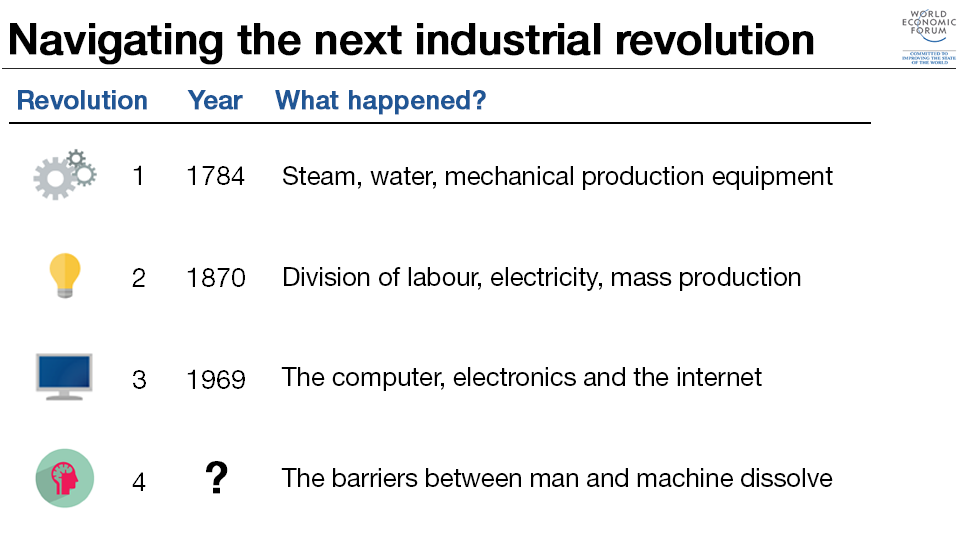Three key ways for companies to succeed in the Fourth Industrial Revolution

Throw the laurels to the side. Surround yourself with top talent. Set a bold course. And get ready to reinvent yourself. Image: REUTERS/Charles Platiau
Every industry is in the process of being affected - if not transformed - by the Fourth Industrial Revolution and the pace of change continues to accelerate as its scale expands.
Following on the heels of the third revolution, defined by the rise of technology and automated production, the fourth revolution reflects the rapidly blurring boundaries between humans and machines. It will affect the very foundations of our society: economic growth, education, financial systems, geosecurity, global trade, health, poverty, and much more.

Many businesses are riding this wave to create enormous value, while others have crashed and burned. But every business is undergoing major change, and five-year mortality rates for U.S. public companies are now running as high as 33%. Even for larger companies, with more than $600 million in sales, 20% will not survive the next five years.
So how can today’s companies beat the odds? Inventing the future will require individual corporations to; escape the constraints of our previous models of success; lead with conviction to create what will and can be; and embrace diversity - the lifeblood of both evolution and innovation.
Strategy 1: Avoid the success trap
As CMO of The Boston Consulting Group, I have the privilege of curating the hundreds of articles we publish each year. In this role, I get to read - a lot. One of my favourites? We just published an article that found that many large companies risk falling into the “success trap.”
There have been good recent writings on how some companies thrive in the face of uncertainty while others underperform or fail, including Great by Choice. But at a time when corporate longevity is declining, we now must focus on a second question: how long will any particular business model last? While large organizations have a strong tendency to overexploiting existing business models instead of exploring opportunities for the future, this is not an inevitability. The most successful companies stay on top by running and reinventing the business at the same time. Explorers grow faster and deliver higher value than exploiters.
Strategy 2: Lead with conviction
But how do companies achieve this? The journey starts with senior leaders who don't shy away from creative destruction inside the company, to avoid becoming a victim of it. During the Fourth Industrial Revolution, we will experience endless waves of disruption, and complacency can be the kiss of death. The best leaders don’t attempt to preserve the past - they invent the future.
Rich Lesser, CEO of BCG, argues that CEOs must upend the status quo even when all is (seemingly) well. Leaders who turn around a successful company may not get the same recognition as those who rescue an organization on the brink of collapse, but they can create massive value.
Strategy 3: Drive the “right” diversity
As a Japanese woman, living in Japan, and mother of three, the topic of diversity in the workplace strikes close to home for me. But diversity is not just a construct designed to right an imbalance. It's an untapped superpower that all businesses have the potential to access.
Diversity offers two major benefits: it buffers change, by avoiding the riskiness of monocultures, but more importantly it creates the platform upon which innovation and adaptation operate. Individuals with varied backgrounds approach business challenges with fundamentally diverse points of view, leading to better innovation and stronger business results.
Research backs this up. A Catalyst report found that companies in the top quartile for board diversity outperformed those in the bottom quartile, with 53% higher return on equity, 42% higher return on sales, and 66 percent higher return on invested capital. I'm proud to say that BCG's executive committee, of which I'm an elected member, has recently reached this 30 percent threshold of women. These performance gains hold true for nearly every industry across the globe.
While the business case for diversity is clear, execution occasionally misses the mark. In recent years, we have seen a wave of publications and pronouncements on the merits of diversity, but as a 2015 B Team Report has shown, efforts can backfire if the spotlight is focused exclusively on just hitting the numbers. Well-intentioned organizations make a mistake when they promote unqualified candidates for the sake of diversity.
While it can be easy to get swept up in the drive to increase numbers, quality trumps quantity every time. It takes time to recruit and promote top talent. Those who get it right will reap the rewards.
To win in this new business environment, where entire systems of production, distribution, and consumption are transforming before our eyes, a change in mindset is needed. What got companies where they are now will not necessarily serve them well going forward. The status quo is no longer a comfortable place to be.
Throw the laurels to the side. Surround yourself with top talent. Set a bold course. And get ready to reinvent yourself. It’s coming sooner than you think.
Author: Miki Tsusaka, Senior Partner & Managing Director, Chief Marketing Officer at The Boston Consulting Group. She is participating in the World Economic Forum’s Annual Meeting in Davos.
Don't miss any update on this topic
Create a free account and access your personalized content collection with our latest publications and analyses.
License and Republishing
World Economic Forum articles may be republished in accordance with the Creative Commons Attribution-NonCommercial-NoDerivatives 4.0 International Public License, and in accordance with our Terms of Use.
The views expressed in this article are those of the author alone and not the World Economic Forum.
Forum Stories newsletter
Bringing you weekly curated insights and analysis on the global issues that matter.





